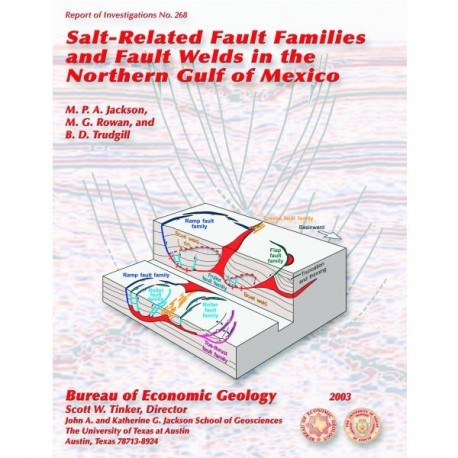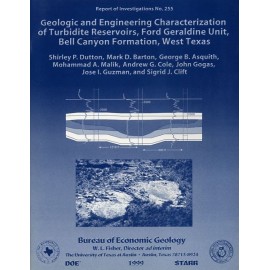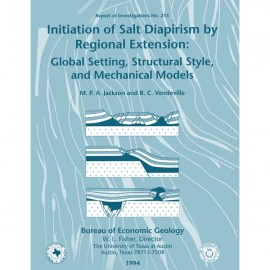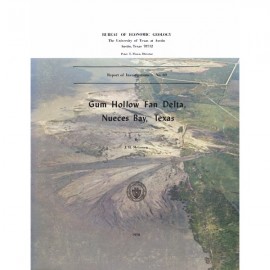Reports of Investigations
-
Books & Reports
- Reports of Investigations
- Guidebooks
- Udden Series
- Geological Circulars
- Down To Earth
- Atlases of Major Oil and Gas Reservoirs
- Texas Memorial Museum Publications
- Environmental Geologic Atlas of the Texas Coastal Zone
- Mineral Resource Circulars
- Other Reports
- Seminars and Workshops
- Handbooks
- Submerged Lands of Texas
- Symposia
- Annual Reports
- Open File Reports
-
Maps & Cross Sections
- Thematic Maps
- Miscellaneous Maps, Charts & Sections
- Geologic Atlas of Texas
- STATEMAP Project Maps
- Geologic Quadrangle Maps
- Cross Sections
- Highway Geology Map
- Energy and Mineral Resource Maps
- Shoreline Change and Other Posters
- Wilcox Group, East Texas, Geological / Hydrological Folios
- Bouguer Gravity Atlas of Texas
- River Basin Regional Studies
- Featured Maps
- Posters
- Teachers & the Public
-
Geological Society Publications
- Gulf Coast Association of Geological Societies
- Alabama Geological Society
- Austin Geological Society
- Corpus Christi Geological Society
- Houston Geological Society
- Lafayette Geological Society
- Mississippi Geological Society
- New Orleans Geological Society
- South Texas Geological Society
- GCS SEPM Publications
- Historic BEG & UT Series
Salt-Related Fault Families and Fault Welds in the Northern Gulf of Mexico
RI0268
For a downloadable, digital version: RI0268D.
RI0268. Salt-Related Fault Families and Fault Welds in the Northern Gulf of Mexico, by M. P. A. Jackson, M. G. Rowan, and B. D. Trudgill. 40 p., 37 figs., 1 appendix, 2003. Print.
To purchase this publication as a download, please order RI0268D.
ABSTRACT
We classify salt-related faults and fault welds in the northern Gulf of Mexico on the basis of the three-dimensional geometry of the faults, welds, deformed strata, and associated salt bodies. Kinematic or genetic criteria are not used in the classification, although we comment on these aspects where they are helpful. Only documented fault styles are considered; those produced by experimental or numerical modeling but not yet observed in the Gulf are excluded.
Extensional faults comprising symmetric arrays include peripheral faults at the landward margin of the original salt basin; crestal faults, which are growth faults rooted in reactive diapirs; and keystone faults at the crests of anticlines. Asymmetric arrays of normal faults are grouped according to their dominant dip direction. Those that dip primarily basinward include roller faults, which are listric growth faults that sole into a subhorizontal salt layer; ramp faults, which extend upward from the landward margin of bulb-shaped salt stocks; and shale-detachment faults, which sole into a shale decollement that merges laterally into a salt layer. Counterregional faults are landward-dipping asymmetric arrays linking cylindrical, basinward-leaning salt stocks. Asymmetric arrays having variable dip direction include flap faults, whose footwalls comprise diapirs overlain by uplifted and rotated roof strata, and rollover faults at the hinges of monoclinal folds. Two families of contractional faults exist: toe thrusts, which are basinward-vergent thrusts that ramp up from a salt or shale d6collement, and break thrusts, which are high-angle reverse faults cutting one or both limbs of detachment folds. Fault arrays that strike parallel to the regional dip direction are termed "lateral faults." Six types of fault welds are defined: primary welds form at the autochthonous level; roho welds are subhorizontal, allochthonous welds into which roller faults detach; counterregional welds comprise both subhorizontal and landward-dipping segments beneath growth monoclines; bowl welds are elliptical and concave upward; thrust welds are landward-dipping surfaces that separate repeated stratigraphic sections; and wrench welds are steep and strike parallel to the regional dip.
Groups of geometrically classified fault families and fault welds are kinematically and genetically linked to each other and to associated salt bodies and welds. Linked fault systems can contain extensional, contractional, and strike-slip components. Extensional fault families are formed by basinward translation, subsidence into salt, or folding. Those that accommodate basinward translation are balanced by salt extrusion or contractional fault families. Strike-slip fault families commonly provide hard links, although various fault components can also be soft linked. Five associations of linked fault systems are directly related to five types of salt systems: autochthonous salt, stepped counterregional, roho, salt-stock canopy, and salt nappe.
Keywords: extension, fault, normal fault, passive margin, salt dome, salt tectonics, salt weld, shortening, strike-slip, structural geology, thrust fault
CONTENTS
Abstract
Introduction
Extensional fault families
Symmetric grabens
Peripheral fault family
Crestal fault family
Keystone fault family
Asymmetric arrays having dominantly basinward dip direction
Roller fault family
Ramp fault family
Shale-detachment fault family
Asymmetric arrays having dominantly landward dip direction
Counterregional fault family
Asymmetric arrays having variable dominant dip direction
Flap fault family
Rollover fault family
Contractional fault families
Toe-thrust fault family
Break-thrust fault family
Strike-slip fault families
Lateral fault family
Fault welds
Primary weld
Roho weld
Counterregional weld.
Bowl weld
Thrust weld.
Wrench weld
Linked fault systems.
Autochthonous salt system
Stepped counterregional salt system
Roho salt system
Salt-stock canopy system
Salt-nappe system
Discussion
Acknowledgments.
References
Appendix: Some salt-tectonics definitions
Figures
1. Tectonic map of the northern Gulf of Mexico showing locations of profiles and maps illustrating fault families
2. Classification system for fault families and fault welds observed in the northern Gulf of Mexico
3. Map of the Mexia-Talco peripheral fault family near the updip limit of autochthonous Louann Salt in East Texas
4. Cross section through the Mexia peripheral fault family
5. Seismic profile illustrating a crestal fault family above a triangular diapir rooted in an allochthonous salt sheet
6. Seismic profile through the Mahogany salt body, comprising a landward salt stock and a basinward salt tongue
7. Time map of the top of the Mahogany salt body showing traces of fault families
8. Bathymetric map of crestal fault families forming a polygonal pattern
9. Cross section of crestal fault family defining a horst on an active diapir, White Castle Dome, Louisiana
10. Seismic profile showing faults in a rollover above a subhorizontal to gently landward dipping salt weld
11. Time slices through rollover fold
12. Seismic profile showing a contractional fold in the Mississippi Fan foldbelt
13. Cross section of a keystone fault family in the crest of an anticline overlying Quitman salt anticline, Wood County, Texas
14. Structure map of keystone fault family in relay pattern cutting top of Paluxy over Quitman salt anticline, Wood County, Texas
15. Structure map of keystone fault family in radial and concentric array cutting top of Frio 4 sand over Anahuac salt stock, Chambers County, Texas
16. Seismic profile of roller faults soling into an autochthonous salt layer and primary weld
17. Roller fault family soling into a subhorizontal allochthonous roho weld with remnant salt rollers
18. Map showing a basinward-dipping roller fault family just offshore of western Louisiana
19. Bathymetric map of a ramp fault family, showing the typical, highly arcuate pattern
20. Seismic profile across ramp fault family
21. Seismic profile of the Oligocene Vicksburg shale-detachment fault family
22. Map of part of the Vicksburg shale-detachment fault family, showing the linear to arcuate fault traces
23. Horizontal time slice at 2,800 ms two-way time through 3-D seismic volume in West Delta/South Pass, showing counterregional fault families extending from and connecting three salt diapirs
24. Seismic profile through counterregional fault family and rollover fault family
25. Seismic profile through a flap fault family on the landward flank of an active diapir, which has uplifted and rotated strata in its footwall since 0.5 Ma
26. Map of a flap fault family, which has a shallow salt diapir in its footwall, on the southern margin of an evacuated salt stock
27. Seismic profile showing contractional folds of the Perdido foldbelt cut on one or both limbs by break-thrust fault families rooted in autochthonous salt
28. Time-structure map of break-thrust fault families cutting folds of the Perdido foldbelt
29. Horizontal time slice at 1,800 ms two-way traveltime showing several lateral fault families
30. Serial seismic profiles across lateral fault family
31. Seismic profile showing a thrust weld
32. Schematic cross section of the northern Gulf of Mexico showing allochthonous salt systems rooted in autochthonous salt above rifted basement
33. Schematic block diagram showing typical assemblage of fault families and salt or fault welds associated with autochthonous salt in the northern Gulf of Mexico
34. Schematic block diagram showing typical assemblage of fault families and salt or fault welds in a stepped counterregional allochthonous salt system
35. Schematic block diagram showing typical assemblage of fault families and fault welds in a roho allochthonous salt system
36. Schematic block diagram showing typical assemblage of fault families and salt or fault welds in an allochthonous salt-stock canopy
37. Schematic block diagram showing typical assemblage of fault families in a salt nappe advancing over the abyssal plain
Citation
Jackson, M. P. A., Rowan, M. G., and Trudgill, B. D., 2003, Salt-Related Fault Families and Fault Welds in the Northern Gulf of Mexico: The University of Texas at Austin, Bureau of Economic Geology, Report of Investigations No. 268, 40 p.






